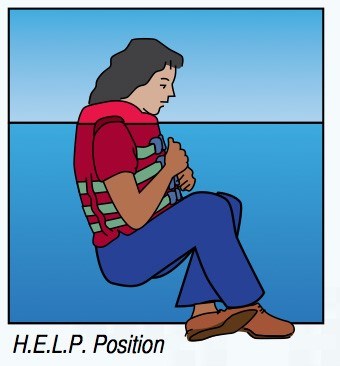Last updated: June 15, 2018
Article
Man Overboard!
No one plans to fall overboard while boating, but accidents do happen. Read our water safety tips to be prepared if you or someone in your vessel falls overboard and needs to be rescued.
What To Do If You Fall Overboard
-
If you do fall overboard, remain calm. Do not exhaust yourself by flailing and thrashing in the water. Your life jacket will keep you afloat. Keep your clothing and shoes on. Air trapped in your clothing can actually help keep you afloat rather than sinking.
-
Get into the H.E.L.P. Position. If you are not able to get out of the water immediately, especially in cold water, bring your knees up to your chest and keep your arms crossed, hugging your lifejacket.The Heat (H) Escape (E) Lessening (L) Position (P) will help keep the major areas of your body from losing heat. Get back into your vessel if you can.

NPS Photo
- If you can get to shore safely, start swimming. Try to get as much of your body out of the water as possible. If you are unable to get back into your vessel, determine if you are close enough to safely swim to shore. Think about how visible you are to other vessels: You do not want to be struck accidentally. Consider the intensity of the current or waves: You do not want to overexert and exhaust yourself. If your route to shore is not safe, stay by your vessel and wait for help.
Responding to Unintentional Overboards
-
First, alert those on the vessel that someone has fallen overboard.
-
Determine if you can safely rescue the person that fell into the water. Assess that you can see them, safely navigate your vessel to them, and assist the person that has fallen overboard. Jumping into the water to go get someone is the last option.
-
If you think you can rescue the person and get them back into the boat:
- Put on your life jacket! Do not try to rescue someone from your boat or jump into the water without wearing your own life jacket. If you are helping the person get back into the boat, you could fall in also. You don’t want to become a victim of drowning.
-
Throw a life jacket or throwable floatation device and pull them back to the boat.
-
Get the person out of the water and to a warm, dry environment. Remove their wet clothing and apply dry blankets to rewarm the victim. Your job is to keep them from getting colder. If someone has been in cold water for a long time, do not give them hot liquids to help warm them up. Call 9-1-1 and seek medical attention immediately.
- If someone is found unconscious in water, get them out of the water, call 9-1-1, and start CPR.
- If you are unable to rescue or locate a person after they fell in:
- Call 9-1-1 for help. There may be circumstances where you are unable to safely reach and help a person that is in the water. Time is of the essence. Be ready to tell the 9-1-1 operator where you are located. A distress call can also be made on Channel 16 of the marine VHF radio. When alerting of your distress, explain the emergency and location so responders can be prepared.
Don’t forget, other types of emergencies such as someone getting lost or injured can occur during your trip. Be prepared ahead of time for emergencies, have an emergency plan for what to do if someone is injured or lost.
Check to see if your park has Junior Ranger Day activities or upcoming events on boating and water safety. Take advantage of water safety days in parks, boat inspections, life jacket fittings and water safety education.
Plan and prepare for your trip with help from the NPS Trip Planning Guide and learn more about your Health & Safety in national parks.
